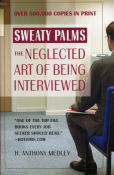| What REALLY goes on in a job interview? Find out in the new revision of "Sweaty Palms: The Neglected Art of Being Interviewed" (Warner Books) by Tony Medley, updated for the world of the Internet . Over 500,000 copies in print and the only book on the job interview written by an experienced interviewer, one who has conducted thousands of interviews. This is the truth, not the ivory tower speculations of those who write but have no actual experience. "One of the top five books every job seeker should read," says Hotjobs.com. | |
|
The Curious Case of Benjamin Button (10/10) by Tony Medley Run Time 167 minutes. There are movies you remember because they become classics and then there are movies or scenes you know you will remember the instant you see them. One example for me of the latter is Danny Kaye in “The Court Jester.” He’s going to drink a toast with his opponent and his friend is going to poison one of the drinks. She tells Danny, “The pellet with the poison is in the flagon with the dragon. The Chalice with the palace has the brew that is true.” Danny struggles to memorize this. Finally he’s got it, but at the last minute she rushes up to tell him, “There’s been a change! The pellet with the poison is in the chalice with the palace. The vessel with the pestle has the brew that is true.” That was too much for poor Danny. He got hopelessly confused, but I never forgot it. Then there was Gene Kelly dancing and singing “Singin’ in the Rain” in a rainstorm (in brown shoes wearing a blue suit!). I was quite young when I saw this but I never forgot it either and knew immediately that I wouldn’t. Now comes the story of Benjamin Button, about a man who is born old and dies young, living his life backwards. This is a movie I won’t soon forget. I don’t know at this point what scenes will stand out, but I know that it is a film that will stay in my consciousness. This story has been around for 150 years, since Mark Twain said, “Life would be infinitely happier if we could only be born at the age of 80 and gradually approach 18.” F. Scott Fitzgerald picked up on it and wrote the short story in 1922. Finally Eric Roth, who won an Oscar® for “Forrest Gump” and also wrote “The Insider,” wrote the screenplay. Roth’s script has been believably translated to the screen by director David Fincher. The story sounds absurd. How can a person live his life backwards? This is a preposterous story, so it took talent to make it believable. In addition to the screenplay and the direction, kudos have to go to visual effects supervisor Eric Barba and special make-up designer Greg Cannom, who created prosthetics to enhance the aging and de-aging throughout the film. It’s really remarkable how Pitt looks like a wizened old man when he is born (and when he is a youngster), and how he gradually loses his age. The story is a flashback as Daisy (Cate Blanchett) lay dying. She asks her daughter, Caroline (Julia Ormand), to read to her from a diary written by Benjamin that she has kept. The make-up on Blanchett makes her such a believable old woman that she is virtually unrecognizable. Brad Pitt plays Button as someone resigned to his fate in life, but who partakes of it in a mostly thoughtful, reactive manner. Even when he realizes that Daisy is the love of his life, he pursues her in a manner that can best be described as impassive. Maybe it was because he knew he was living life backwards, but Button’s priorities were right on. He wasn’t interested in money; he was interested in living a good, considerate life. This is a moral one doesn’t see in many movies and I wonder how many will notice it. Pitt, Blanchett, and Ormand give stellar performances. This is the second film in a row that Pitt has looked like a real actor to me. However, much as I enjoyed the movie, there is something to criticize, although it might be of interest only to a critic. I asked for a list of cast & crew when I checked into the screening at the Sherri Lansing Theater on the Paramount lot. I was told they didn’t have one. I asked why not. I was told that it was an expense and they wanted to save the money. I replied that all the information is included in the closing credits, so how much could it cost to print it out? I was informed that they had to save the money. I replied, “You spend $100 million on a film and you can’t afford to print out a list of cast and crew to distribute to critics?” The question went unanswered. Maybe the movie is great, but the people who run the studio still aren’t ready for prime time. Sure, it’s probably way too long. I still believe that movies shouldn’t exceed 90 minutes, and those that do are suffering from a surfeit of director’s ego. But this is a movie of such emotional poignancy that the length didn’t bother me that much. It’s best seen with lots of tissues at the ready. When it finally ended, I was emotionally spent. December 18, 2008 |
|
|
|
|
